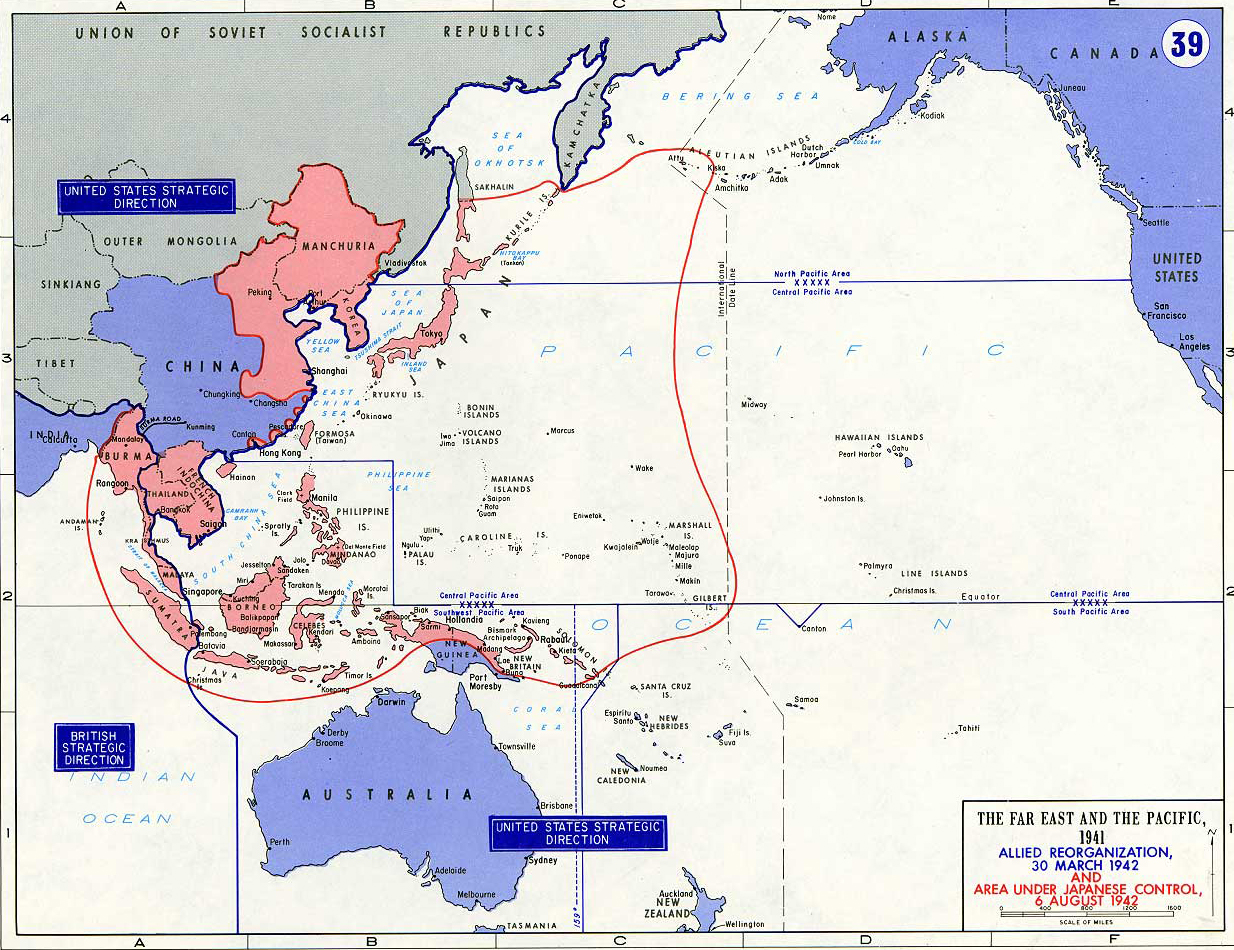Map Description
History Map of WWII: The Far East and the Pacific 1942
Illustrating:
- Allied Reorganization — March 30, 1942
- Area Under Japanese Control — August 6, 1942
1. Allied Reorganization — March 30, 1942
Strategy changes were driven by the urgent need for more effective Allied coordination and response, especially
after the collapse of the ABDA (American-British-Dutch-Australian) Command in the Dutch East Indies in
February-March 1942.
By March 30, 1942, the Allies had implemented a major reorganization of their command structure in the Pacific theater.
Admiral Chester Nimitz assumed command as Commander-in-Chief, Pacific Ocean Areas (CINCPOA)
on December 31, 1941,
overseeing three operational areas in the Pacific under US command. In this role, he commanded all US and Allied
naval, air, and ground forces across these areas.
-
North Pacific Area (above 42°N):
Covered Alaska and Aleutian Islands; commanded by Rear Admiral Robert A. Theobald.
-
Central Pacific Area:
Hawaiian Islands and central Pacific approaches; directly commanded by Admiral Nimitz himself, in addition to his overall role as CINCPOA.
-
South Pacific Area:
South Pacific islands including New Caledonia, Fiji, New Hebrides, and approaches to Australia; placed under Vice Admiral Robert L. Ghormley.
In addition, General Douglas MacArthur assumed command as Supreme Commander of the Southwest Pacific
Area (SWPA) on April 18, 1942. As such he was in charge of all U.S. and Allied forces (naval, air, and ground forces) in that
specific theater, which included
Australia, the Philippines, New Guinea, and surrounding areas.
Note: On February 20, 1942, President Roosevelt ordered MacArthur to escape Bataan for Mindanao and then
proceed to Melbourne, Australia, where he would assume command of all U.S. forces in the region. MacArthur arrived in Melbourne
on March 21, 1942, where he set up headquarters and took command in April.
Both MacArthur and Nimitz reported directly to the U.S. Joint Chiefs of Staff, but each had authority over different
regions and operational responsibilities. MacArthur was not subordinate to Nimitz; rather, they were parallel commanders
in their respective areas.
And hence Britain ceded significant operational control in the Pacific to the Americans.
British strategic focus shifted to defending India (Japanese forces had invaded Burma (Myanmar) in December 1941, and captured
Rangoon in March 1942) and maintaining supply lines to Australia and New Zealand.
Note: In 1942, there was no British-controlled Southeast Asia Command (SEAC) yet.
The Southeast Asia Command was officially established later, in August 1943, with Admiral Lord Louis Mountbatten appointed as
the Supreme Allied Commander.
Therefore, in a nutshell, the Allied reorganization by March 30, 1942:
-
divided the Pacific theater into two main commands:
- Pacific Ocean Areas (POA): Commanded by Admiral Nimitz
- Southwest Pacific Area (SWPA): Commanded by General Douglas MacArthur
- Pacific Ocean Areas (POA): Commanded by Admiral Nimitz
- established clear division of responsibilities and resolved command conflicts that had hampered early war efforts
- enabled coordinated strategic response against Japanese expansion
- marked a shift in power dynamics with the US assuming primary leadership in the Pacific theater
2. Area Under Japanese Control — August 6, 1942
By August 6, 1942, the Japanese Empire had reached the peak of its territorial expansion in the Far East and Pacific,
following rapid advances after the attack on Pearl Harbor in December 1941.
The Japanese perimeter stretched from the Aleutian Islands in the north (where they briefly occupied Attu and Kiska)
to the Solomon Islands in the south, and from Burma in the west to the central Pacific islands in the east.
By August 1942, the Japanese were at the threshold of Australia, with their southernmost advances in New Guinea only
about thirty miles from Port Moresby.
This vast area included most of the habitable and strategically significant islands and coastal territories in the
western and central Pacific.
Turning Point: August 1942 marked the beginning of major Allied counteroffensives, notably
the U.S. landing on Guadalcanal
(August 7, 1942), which would signal the gradual rollback of Japanese territorial gains.
Credits
Courtesy of the United States Military Academy Department of History.
Related Links
About the Second World WarWWII Timelines

